 Image search results - "ana" Image search results - "ana" |

Haneda to Tokushima
|
|

Occupying a huge plot of land in the center of the city, Kanazawa Castle has undergone extensive renovations and reconstruction. The main castle buildings are now magnificently restored.
|
|

Kenrokuen is one of Japan's three most famous gardens (besides Korakuen in Okayama and Kairakuen in Mito, Ibaraki). The garden was originally the castle garden for Kanazawa Castle. Katsurazaka Entrance to Kenrokuen Garden 桂坂口
|
|

Map of Kanazawa Castle Park and Kenrokuen Garden
|
|

Established in 1617, Tsukiji Hongwanji temple is the Tokyo headquarters of the Nishi Hongwanji Jodo Shinshu sect. The present temple, based on Indian architecture, was built in the 1930s.The temple is the only one in Japan which is under the direct control of the sect. Its head priest is the Monshu Abbot himself. April 8 is observed as Buddha's birthday, called Hana Matsuri ("Flower Festival) in Japan.
|
|

Kanagawa Prefecture's largest Awa Odori is held annually during the last weekend in July in this city of Yamato. Preview event near Yamato Station.
|
|

Kanayama Jinja Shrine is a small shrine within the grounds of the Wakamiya Hachimangu Shrine near Kawasaki Daishi Station. On the first Sun. of April, it holds this now-famous Kanamara Festival nicknamed the Phallus or Fertility Festival. Festival starts at 11 am. But a large crowd was already there well before that time. Entrance to shrine on the day of the Kanamara Festival. (If you're below age 18, please leave now.)
|
|

Chiba Castle as seen from Kencho-mae monorail station.
|
|

From late April to early May, five long strings of giant carp streamers swim in the air high above the Sagami River in Sagamihara, Kanagawa. This event was started in 1988.
|
|

JR Kofu Station
|
|

Hi Philbert! Welcome aboard!
|
|

Kanazawa Castle was the base for the Kaga Domain (Ishikawa and Toyama Prefectures) ruled by the Maeda clan 1583–1871 starting with Maeda Toshiie.
|
|

Entrance to Inohana Park
|
|

Ninomaru Northern Stone wall along a moat. 二の丸北面石垣
|
|

Kenrokuen is classified as a "kaiyu-shiki teien" (回遊式庭園) or "circular-strolling Japanese garden." It's a common and classic Japanese garden design where you simply walk around the garden, usually around a central pond.
|
|

Tsukiji Hongwanji temple gate with wisteria crest.The emblem is a wisteria flower and symbol of the Jodo Shinshu sect.
|
|
|
|

Shrine banners and cherries in full bloomThe red banner says "Kanayama Jinja" with an phallus (erect) logo on the top.
|
|

There are five rows of streamers. In Japan, the koi carp is regarded as a symbol of valiant manhood because it swims up the river against the rapids.
|
|
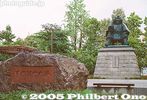
Park in front of Kofu Station.
|
|
|
|

Path to Chiba Castle (visible on left)
|
|

Shinmaru Park 新丸広場
|
|

Kasumigaike Pond and the famous Kotoji-toro stone lantern. The lantern is shaped like a bridge that supports a string on the koto instrument. 霞ヶ池 徽軫灯籠
|
|

Temple gate and flag
|
|

Pre-festival event held in the afternoon, Yamato Awa Odori
|
|

Pumping (or humping) the...
|
|

The cable length is 250 meters and 13mmm thick. There are about 1,200 carp streamers. They are reused every year and donated by local families. (I also noticed a few advertising carps.)
|
|

Statue of Takeda Shingen.
|
|
|

Chiba Castle and paper lanterns
|
|

Dobashi-mon Gate stone walls 土橋門石垣
|
|

Famous Kotoji-toro stone lantern 徽軫灯籠
|
|

Play room for kids on Hanamatsuri
|
|
|

The festival is wildly popular with people from overseas.The shrine had various phallus props to pose with.
|
|
|
|

Highway in front of the castle.
|
|

Chiba Castle Sakura Matsuri lantern
|
|

Dobashi-mon Gate stone wall 土橋門石垣
|
|

Hanamatsuri altar
|
|

The strolling path is not a perfect circle, but you start and finish at the same point. The strolling path is lined with Japanese pines, flowering plants, maples, etc.
|
|

Yamato Station
|
|

Dickhead hat. Actually, I don't know what they call it, but that's what I call it.
|
|
|
|

Outer castle wall
|
|

Chiba Castle tower
|
|

Dobashi-mon Gate stone wall. Notice the hexagonal stones. 土橋門石垣
|
|
|
|

Pouring sweet tea over the BuddhaWhen the Buddha was born in Lumbini Garden in Nepal, sweet rain is said to have fallen. Thus, sweet tea is poured over the baby Buddha statue in the Hanamatsuri altar.
|
|

Balloons, souvenirs and trinkets sold near the train station.
|
|

Carving daikon. Anybody can join in and carve. 大根削りLater to be auctioned off.
|
|

Sagami River Koi-nobori
|
|
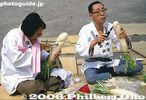
Carving daikon (old photo). These men were really good at carving the daikon.
|
|
|

Chiba Castle
|
|

Gate to Former Brigade Office 切手門
|
|

Karasaki Pine Tree in Kenrokuen Garden, Kanazawa, Ishikawa Pref.
|
|

Hanamatsuri celebrates the Buddha's birthday on April 8. This is Tsukiji Honganji in Tokyo.The flowers symbolize Lumbini Garden where the Buddha was born in present-day Nepal.
|
|
|
|
|
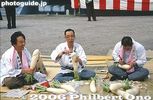
Carving daikon. Since some activities are conducted on the ground, the festival is also called Jibeta (Ground) Matsuri.Once upon a time, the festival was still mostly a local event with much fewer people.
|
|

Ishikawa Bridge to Ishikawa-mon Gate
|
|
|

Former Brigade Office (closed to public) 旧第六旅団司令部
|
|
|

Baby Buddha statueLadles are provided for pouring the sweet tea over the Buddha. Sweet tea is also provided to worshippers. It symbolizes the sweet rain that fell when the Buddha was born.
|
|

Main drag and shopping arcade called Yamato Chuo-dori大和中央通り
|
|
|
|
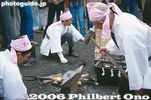
Forging a steel phallus (old photo)The demon living in the vagina of the women bit the man's phallus each time. So one guy made a steel phallus and the demom broke his teeth.
|
|

Ishikawa-mon Gate 石川門
|
|

Sukiyashiki stone wall. Some markings are engraved on the stones. 数寄屋敷石垣
|
|

Children dressed for the chigo parade, Tsukiji Hongwanji, TokyoIt took a long time before they could get all the kids to settle down for the picture and to get all the mothers out of the picture.
|
|

Ropes are strung over the tree to protect it against the weight of snow.
|
|

Spectators wait for the parade to begin.
|
|

Cherry blossoms and Chiba Castle
|
|
|
|

JR Kanazawa Station JR金沢駅
|
|

Passing through Ishikawa-mon Gate 石川門
|
|

Gokuraku-bashi Bridge 極楽橋
|
|

Children dressed for the chigo parade (photo session), Tsukiji Hongwanji, Tokyo
|
|

Karasaki Pine Tree in Kenrokuen Garden 唐崎松
|
|

Sugawara house from Tsuruoka city, Yamagata Prefecture. In heavy snow, the front window was used as the door.
|
|

June 9, 2007. Hula dancers rush to Pukari Sanbashi Pier where the Hokule'a canoe is to dock. ぷかりさん橋
|
|

The festival/parade starts before dark.
|
|

Omatsuri is actually a place name. The small settlement has a lodge and restaurant.
|
|

Bus to Taba. The bus runs from Okutama Station in Tokyo. It is the only public transportation link with the village.
|
|

Standing room only at Wakamiya Shrine
|
|
|
|

The longest carp is 10 meters.
|
|
|

Stone walls seen from Gokuraku-bashi Bridge.
|
|

Going to the chigo parade's starting point
|
|

The Karasaki Pine Tree is the garden's largest pine tree.
|
|

Ceiling
|
|

A crowd of a few hundred on hand to greet Hokule'a's arrival.
|
|
|
|

Omatsuri bus stop for Okutama.
|
|

I was in Okutama and noticed that the bus goes on to Tabayama village in neighboring Yamanashi. I got really curious and rode the bus to Tabayama. This is central Tabayama.
|
|

Packed path to Wakamiya Hachimangu Shrine
|
|
|
|
|
|

Sanjukken Nagaya Armory (closed) 三十間長屋
|
|

White elephant to anchor the parade. Notice the Buddha altar riding on the top. Before she gave birth to the Buddha, Queen Maya dreamed of a white elephant.
|
|

Karasaki Pine Tree in Kenrokuen Garden, Kanazawa, Ishikawa Pref.
|
|

Kitamura house brought from Hadano, Kanagawa
|
|

People crowd the waterfront near Pukari Sanbashi Pier.
|
|
|
|

Omatsuri bus stop for Taba.
|
|

When I walked around, my planned 20-min. stay turned into a 2-hour walking tour of this pacifying place, full of mountains and a clear river. A delightful discovery. Suigen Park
|
|

Prayers to the Kanamara Boat portable shrine かなまら舟神輿 神輿御霊入れ式Before the portable shrine is taken out to be paraded around town, the god of the shrine must be transferred to it. This is what the head priest is doing.
There are three portable shrines (called mikoshi). The Kanamara mikoshi (the original portable shrine), Kanamara-bune mikoshi (shaped like a boat), and Elizabeth mikoshi (pink giant). All three are carried during a procession around town. The Elizabeth mikoshi is carried by she-males. ("New half" in Japanese. Go ahead and laugh if you want.)
|
|
|
|

Along the river were food stalls.
|
|

Ishikawa-mon Gate looking from the inside. 石川門
|
|

Sanjukken Nagaya Armory (closed) 三十間長屋
|
|

Start of the Hanamatsuri parade which also promotes traffic safety.The starting point was a nearby park.
|
|
|

Kitamura house
|
|

People crowd the waterfront near Pukari Sanbashi Pier.
|
|
|
|

On the side of the road near the bus stop, there is a trail going down to Tama River.
|
|

Completely surrounded by mountains with a clear river running in the middle.
|
|

Prayers to the Kanamara-bune mikoshi かなまら舟神輿Before the portable shrine is taken out to be paraded around town, the god of the shrine must be transferred to it. This is what the head priest is doing.
|
|

Cherry blossoms and Chiba Castle
|
|

Festival site
|
|

Ishikawa-mon Gate stone wall
|
|

Kurogane (Tetsu)-mon Gate stone walls. Entrance to Honmaru. 鉄門石垣
|
|

Parade starts...
|
|

Horai island 蓬莱島
|
|

Nihon Minkaen is an outdoor museum of traditional farm and merchant houses with thatched roofs. They have 25 homes from around Japan many were donated to the museum for preservation.
|
|

Hokule'a already in sight well before 11 am when it was scheduled to dock.
|
|
|
|

A suspension bridge over the river.
|
|

A few bridges span the river.
|
|

The shrine's head priest transfers the deity to the Kanamara Boat portable shrine (boat-shaped loaded with a phallus) かなまら舟神輿Before the portable shrine is taken out to be paraded around town, the god of the shrine must be transferred to it. This is what the head priest is doing.
|
|

Corners
|
|

Cable anchor
|
|

Ishikawa-mon Gate stone wall (different pattern from other wall).
|
|

Kurogane-mon Gate stone wall 鉄門石垣
|
|

Baton-twirling club from the Chiyoda Jogakuin Junior/Senior High School followed by the elephant千代田女学院
|
|

Statue of Prince Yamato Takeru 日本武尊像(明治紀念之標)Memorial built in 1880 dedicated to the fallen warriors of Ishikawa Prefecture who fought in the Satsuma Rebellion.
|
|
|

Hokule'a and escort ship Kama Hele. What makes this canoe so special and famous is that it was used to sail from Hawaii to Tahiti (and many other places) without any modern navigational instruments.
|
|
|
|

Tama River as seen from the bridge.
|
|
|

A representative of the shrine parishioners offer prayers.
|
|

Front view
|
|
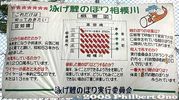
Statistics
|
|

Ishikawa-mon Gate 石川門
|
|

Kurogane-mon Gate stone wall 鉄門石垣
|
|

Chigo children
|
|

Statue of Prince Yamato Takeru 日本武尊像
|
|
|

They only referred to the sun, moon, the stars, and ocean waves to navigate through the vast Pacific Ocean or Polynesia. This is called celestial navigation. Extremely few people can do this, and the Hawaiians are learning this skill of long-ago.
|
|
|
|

Tama River
|
|

Tama River, looks very inviting in summer.
|
|

Prayers to the Elizabeth portable shrine エリザベス神輿Before the portable shrine is taken out to be paraded around town, the god of the shrine must be transferred to it. This is what the head priest is doing.
|
|
|
|

San-no-maru and Gojukken Nagaya long house and turrets in the distance.
|
|

Site of Inui Yagura Turret 戊亥櫓跡
|
|

On the road in front of the temple
|
|

Neagari-no-matsu Pine tree with rising roots. 根上松
|
|

Thatched roof
|
|

They wanted to prove that the original native Hawaiians were able to sail between Tahiti to Hawaii on purpose, and that they did not land on Hawaii by accident.
|
|
|

Tama River, very quiet and peaceful.
|
|

Upriver as seen from the bridge.
|
|

Waving the sacred sakaki branch to bless all of us
|
|
|
|
|

View from Inui Yagura Turret
|
|

Baton-twirling club, Tsukiji Hongwanji, Tokyo 千代田女学院 バトン部千代田女学院
|
|

Neagari-no-matsu Pine tree with rising roots. 根上松
|
|

Water nozzles aimed at the house. No smoking.
|
|

Hokule'a and Yokohama Bay Bridge in the background.
|
|
|

Crystal clear water of Tama River
|
|
|
|
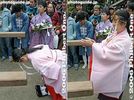
Prayers to the Elizabeth portable shrine エリザベス神輿Before the portable shrine is taken out to be paraded around town, the god of the shrine must be transferred to it. This is what the head priest is doing.
|
|
|
|

View from Inui Yagura Turret. Hashizumemon Gate on lower right.
|
|

Female schoolmates of the baton twirlers block the cameras of unrelated photographers when the baton twirlers passed. カメラ小僧を妨害するバトン部の先輩たち。This was the first time for me in Japan to see people blocking photographers from taking pictures at a festival. They did it to me as well. If they don't want to be photographed, why do they appear in this public festival??
妨害しても無駄だと思いますが。撮られるのがいやでしたら、まつりに出ない方がいいですよ。
|
|

Winter cherry blossoms.
|
|
|

One sail unraveled.
|
|
|

Crystal clear water of Tama River with fall leaves.
|
|
|

Elizabeth portable shrine エリザベス神輿Before the portable shrine is taken out to be paraded around town, the god of the shrine must be transferred to it. This is what the head priest is doing.
There are three portable shrines (called mikoshi). The Kanamara mikoshi (the original portable shrine), Kanamara-bune mikoshi (shaped like a boat), and Elizabeth mikoshi (pink giant). All three are carried during a procession around town. The Elizabeth mikoshi is carried by she-males. ("New half" in Japanese. Go ahead and laugh if you want.)
|
|

Statue of Chiba-no-suke Tsuneshige and Chiba Castle tower 千葉介常重Lord Chiba-no-suke Tsuneshige was the founder of Chiba Castle in 1126.
|
|

Water intake for Lake Biwa Canal No. 2. Near Mihogasaki in Otsu, and adjacent to the boat racing arena.
|
|

Kanazawa Castle
|
|
|
|

Band from the Chiyoda Jogakuin Girls Junior/Senior High SchoolNo problem photographing them.
|
|

Gardeners
|
|

The cherry blossoms lining Sotobori Moat also look stunning from the road, Sotobori-dori in front of Kagurazaka.
|
|
|
|

Nearing Pukari Sanbashi Pier. The question was, which side of the pier would it dock? (Was going the other side so I rushed over to the other side.)
|
|
|
|

Trout fishing ponds for customers in warmer months.
|
|

Pubic hair not included. Perhaps that's why it doesn't look so obscene.
|
|

Statue of Chiba-no-suke Tsuneshige built in Dec. 2001 to commemorate Chiba city's 80th anniversary. 千葉介常重Lord Chiba-no-suke Tsuneshige was the founder of Chiba Castle in 1126.
|
|

Hashizume-mon Turret 橋爪門続櫓
|
|

Hashizumemon-tsuzuki Yagura Turret
|
|

The elephant follows the band.
|
|
|

People in a long line waiting to enter Canal Cafe to either dine or rent a rowboat.
|
|
|
|

Hokule'a nears the dock.
|
|

Mime act depicting a kite
|
|

These photos were taken in Feb. Probably scenic in fall.
|
|

Riverside fishing ponds
|
|

Elizabeth portable shrine was donated by a drag queen club called Elizabeth Kaikan in Kameido, Tokyo.There are three portable shrines (called mikoshi). The Kanamara mikoshi (the original portable shrine), Kanamara-bune mikoshi (shaped like a boat), and Elizabeth mikoshi (pink giant). All three are carried during a procession around town. The Elizabeth mikoshi is carried by she-males. ("New half" in Japanese. Go ahead and laugh if you want.)
|
|

Statue of Chiba-no-suke Tsuneshige 千葉介常重Lord Chiba-no-suke Tsuneshige was the founder of Chiba Castle in 1126.
|
|

Gojukken Nagaya long house connected the two turrets on each end.
|
|

View from Inui Yagura Turret
|
|

Entering the temple gate
|
|

Tiny pink flowers
|
|

Hinokawa Dam Park 日野川ダム公園
|
|

Canal Cafe is right below the cherries. But notice empty tables despite the long line.
|
|

Yamada house
|
|

A rope is thrown to the dock from Hokule'a.
|
|

A fool's dance.
|
|

Mountain with a patch of green.
|
|

Path to Otaki Waterfalls 雄滝
|
|

Kanamara Boat portable shrine (boat-shaped loaded with a phallus) was donated by a steel company. かなまら舟神There are three portable shrines (called mikoshi). The Kanamara mikoshi (the original portable shrine), Kanamara-bune mikoshi (shaped like a boat), and Elizabeth mikoshi (pink giant). All three are carried during a procession around town. The Elizabeth mikoshi is carried by she-males. ("New half" in Japanese. Go ahead and laugh if you want.)
|
|

Stone wall at entrance
|
|

Hishi-yagura Turret 菱櫓
|
|

Inui Yagura Turret stone wall as seen from Hashizumemon-tsuzuki Yagura Turret.
|
|

Final performance
|
|

Kasumigaike Pond
|
|

Empty rowboats too.
|
|
|

Hokule'a arrives right on schedule at 11 am on June 9, 2007. Yokohama is its last stop.
|
|

End of the parade route.
|
|

Bus stop. Notice the monkey crossing the road.
|
|

Waterwheel 水車
|
|

Two of the portable shrines ready to go. In Japanese, the festival is nicknamed "Chinko Matsuri" (Phallus Festival) ちんこ祭り.There are three portable shrines (called mikoshi). The Kanamara mikoshi (the original portable shrine), Kanamara-bune mikoshi (shaped like a boat), and Elizabeth mikoshi (pink giant). All three are carried during a procession around town. The Elizabeth mikoshi is carried by she-males. ("New half" in Japanese. Go ahead and laugh if you want.)
|
|

Steps to front entrance
|
|

Cherry trees along the Sotobori Moat. Formerly a moat of Edo Castle, this canal stretching from Iidabashi Station to Ichigaya Station along the Chuo Line.
|
|

Hishi-yagura Turret 菱櫓
|
|

Magnificent tree
|
|

The parade was over after 30 min. (11:30 - 12 pm).
|
|

Karasaki Pine Tree
|
|
|

Hula dancers
|
|
|
| 5693 files on 23 page(s) |
1 |
 |
 |
 |
 |
|